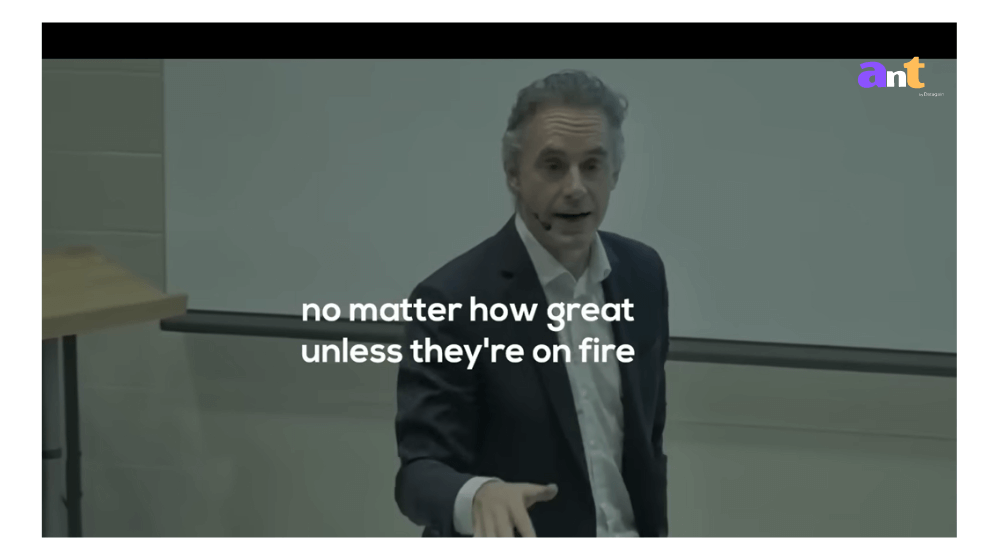
Home » Transcript Library » Psychology » Jordan Peterson Reveals The Psychology Behind Selling Anything Transcript
Jordan Peterson Reveals The Psychology Behind Selling Anything Transcript
Jordan Peterson 00:00:03
You can’t really create a product and then launch it because first of all, you don’t know how to do that. You might know how to create the product, but you do not know how to market or sell it. You don’t know how to advertise it. You don’t know how to communicate about it. You don’t know how to ship it. Like there’s all sorts of things you just don’t know. But worse is you don’t know if people will use it. And so, what companies that… that roll out new products on a relatively continual basis do is they don’t develop the product and then go sell it. They continually communicate with their customers about what product the customer is willing to buy next, and then they develop that. And so, you have to have your market identified and then you have to be in continual communication with the market while you develop the product. It’s not, I build a better mousetrap and the world comes marching to my door. That isn’t how it works. You got to find out if someone wants to buy your stupid thing.
00:00:49
And then the next thing is that even if you have a great thing, you’re going to go talk to people and they have 50 great things that they might buy and they’re all great, but they’re not going to buy all 50. They might buy one maybe, and maybe they’ll buy it this week, but probably they’ll buy it in six months, and they’re not going to buy any of them no matter how great, unless they’re on fire and you’re selling water because they’re so busy already, right? They’re so overwhelmed and preoccupied by their jobs that if you come in and you say, well, here, this is going to increase your efficiency by 20%, and here’s the three weeks you’d have to spend doing that, and then the payoff would come in the next years, they’ll say, yeah, well, I’ll do that as soon as I have time. As soon as I have time is never. So, if they’re on fire and you have water, you can sell it to them. But that’s all, because otherwise it’s a no go.
00:01:31
Those are all things that are worthwhile knowing because they’re very hard to learn and very comically, I mean, if you would have told me when I first started developing these tests that one of the reasons corporations wouldn’t buy them was because they worked, that I would have just thought, really? I mean, come on, really? That’s really the reason. It’s like, yeah. Yeah, that’s the reason. Very, very problematic. And then they already have their processes in place, and they’re entrenched.
00:01:55
And then, the next problem is, you know, you haven’t got any customers—I think I told you that before—you don’t have any customers and you show them the statistics, but they can’t understand the statistics and they also have 200 other people selling them things, and 50 of them are crooks. So, they’re just lying about what they’re doing, and they can’t tell the difference between the liars and the people who are telling the truth and so, they can’t understand the statistics for themselves, and they can’t verify them anyways. So, what they ask you is, who else is using it? And if the answer is, well, everybody, then you don’t even have to do the sale because you’re already rich. And if the answer is nobody, then they’re going to say, well, why is nobody using this? You say, well, it’s the hardest thing that’s come along and they think, well, I’m not going to be the sucker who gets painted, you know, red and fired because this failed, that they do not think this might make me succeed. People do not care about whether or not they succeed. They care about whether or not they fail.
00:02:45
And so that’s another thing is that if you’re marketing something and you can say this will stop you from being identified as a failure, then people might be happy about that. But if you say this will really help you succeed, it’s like, yeah, yeah. No, I don’t want to succeed. I just don’t want to fail. I don’t want to succeed. I just want to be invisible and be left alone. And if you’re looking for people’s fundamental motivation, that’s it. It’s—they want to be invisible, and they want to be left alone.
00:03:11
I tell you the zebra story? Do any of you know that story? Okay, I’ll tell you this zebra story. Stop me if I’ve told it to you before. This tells you everything you need to know about human beings, so it’s worth knowing. Okay, so zebras have stripes and people say, well, that’s for camouflage. And then you think about that for two seconds and you think, that’s a really stupid theory because lions are camouflaged and they’re golden like the grass and zebras are black and white. So, you can see a zebra five miles away. It’s like, there’s a zebra, it’s black and white. So, the whole camouflage thing, that’s just not working out so well as a hypothesis. Okay, so biologists go, and they decide to take a look at some zebras and so they’re looking at a zebra on the herd because there’s no zebra, right, just like there’s no fish. There are schools of fish and there are herds of zebras. There isn’t a fish. This is why I think the cod aren’t coming back. There are no cod. There are massive 100-mile-long schools of cod, 10 stories deep, 20 million years old. You wipe out the school, you don’t just get to throw a cod in the water and say, well, off you go. It’s like, well, where’s my city? It’s like launching you in the middle of a field. It’s like, well, go out there and reproduce. It’s like, no, that’s not going to happen. So, without the school, there’s no cod and you can’t just introduce a whole school of cod because you don’t have a whole school of cod. So, you know, maybe the cod are never coming back.
00:04:30
And zebras are the same thing. There’s not a zebra, there are zebras. You’re looking at the zebras trying to study a zebra and you look at the zebra and you make some notes, and you look up and you think, oh, Christ, which zebra was I looking at? And the answer to that is, you don’t know because the camouflage is against the herd, and the black and white stripes. There’s a variety of reasons for the stripes—the flies also seem not to like the stripes, but, you know, usually, things evolve for multiple reasons. But anyways, it’s very difficult to parse out a zebra against the herd. You look down, you look up, it’s like, uh-oh, all those damn zebras look the same. Yes, the camouflage is effective but it’s against the herd. So, then you think, well, we better identify a zebra so we can see what he’s up to. So, then you take your Jeep and a can of red paint and a stick with a rag on the end of it. You drive up to the zebras and you paint their haunch red a little bit, put a nice red dot on their haunch or maybe clip their ear with a cattle clip. And then you, you know, you stand back, and you think, hey, I’m pretty smart. Now, I’m going to watch that zebra.
00:05:21
So, what do you think happens to the zebra? The lions kill it, right? Because lions, they’re smart, right? Hunting animals are smart, but they have to identify a zebra before they can organize their hunt. They can’t just hunt the whole herd. They have to pick out a zebra. And so maybe it’s like a zebra that’s got a sore hip or something. And so, you think, well, nature’s kind, it just takes the weak. It’s still no, lions like really healthy, delicious zebras. But they look like all the other healthy, delicious zebras so they can’t get a bead on them. But if they’re small and just born or if they’re limping or there’s something that identifies them, then the lions can pick them out and then they do pick them out.
00:05:59
And so, the rule for human beings is keep your damn stripes on so the lions don’t get you. And I’m telling you, man, if you want to remember one thing from my class about human motivation, that’s a good thing to learn. People camouflage themselves against the herd and they like to be in the middle of the herd, which is what fish do, by the way. If you have a big school of fish, the smart, healthy large fish are in the middle of the school because you know what you call fish on the outside of the school? Bait. So that’s what people are doing. They are trying to move into the middle of the herd all the time and the herd moves around, or the school moves around, and people are going, well, I’m in the middle, I’m staying in the middle here. So, I’ve got this protective ring of people around me, so the predators don’t pick me out and do me in.
00:06:41
Okay. So, that’s part of the reason why I said, well, you can’t sell something to someone for success because, you know, you’re thinking, well, people are aiming at success. Don’t be thinking that. It’s not by any means necessarily true. Trait neuroticism is a powerful motivator and trait neuroticism is, let’s not be too threatened or hurt, right? That’s the negative emotion system and the negative emotion system is a killer source of motivation. You know, you also see that there are scales of well-being that have been designed, mostly by social psychologists, which means they’re very bad scales most of the time because their psychometric capacity is absurdly low, generally speaking. So, what you find with scales of well-being, sometimes they’re talked about as scales of happiness even, is that people aren’t after happiness, they’re after not hurting. It’s not so they don’t want to be extroverted and enthusiastic, right? And bubbly and full of smiles and laughter, that isn’t what they mean by I want to be happy. What they mean is, I don’t want to be anxious or in pain. And so, well-being scales tend to be something like neuroticism, emotional stability plus extroversion. But the big loading is on emotional stability, the reverse of neuroticism. You want to avoid suffering. You don’t want to be happy, you want to avoid suffering. And one way to avoid suffering is not to let the lions gnaw on you. And one way of doing that is to stay in the middle of the damn herd.
00:07:54
And so, like, I’m not being a smart aleck about this. I understand why people do that. There’s real danger to being visible. There’s real danger in being visible. Now, you might be successful if you’re visible, but you also might be dead.
Copyright Disclaimer
Under Title 17 U.S.C. Section 107, allowance is made for “fair use” for purposes such as criticism, comment, news reporting, teaching, scholarship, and research. Fair use is permitted by copyright statute that might otherwise be infringing.






